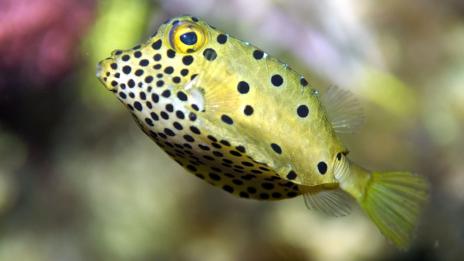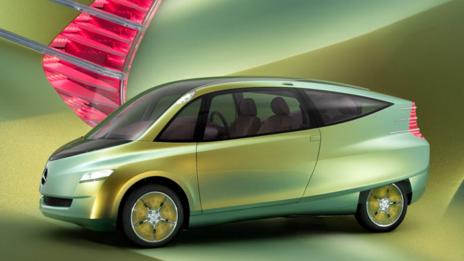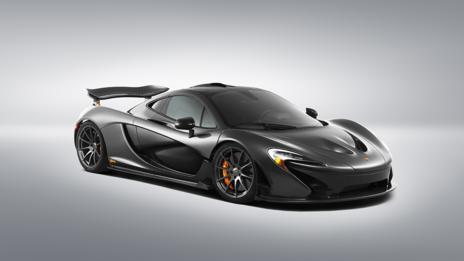How would your boss react if he had to sign off for an expensive stuffed fish you’d bought on a whim on your holiday? Most of us would probably answer “not very thrilled”. But Frank Stephenson’s boss is not your average boss; his workplace is not your average workplace; and the fish? Well, that’s not your normal fish either.
Stephenson is design director of McLaren Automotive, the carmakers behind a range of highly prized, high-priced cars. While on holiday in the Caribbean, he noticed a sailfish on a wall in the resort where he was staying. A man working there told Stephenson that he was proud to have caught the fish because it was so fast. Stephenson was intrigued – he began doing some research on the species to find out why it was so quick.
The McLaren P1 hybrid supercar uses design tricks inspired by the sailfish’s skin (McLaren)
On the way back to London, Stephenson stopped off in Miami and went down to a local fishing village, where, in a stroke of luck, a local fisherman had just caught a sailfish. He bought it, sent it downtown to get it stuffed and eventually got it delivered to the scanning department of the McLaren Automotive aerodynamics laboratory in Surrey – where the carmakers set to work trying to learn the secrets of the super-speed fish’s abilities. It’s just one of a number of recent initiatives by automotive companies to try and learn from techniques that have been used in nature.
The sailfish is a kind of turbo swordfish; one that has been clocked swimming 100m in around half the time it takes Usain Bolt to run it. They are capable of these bursts of breath-taking speed in order to chase down the small, fast-swimming fish they eat. The analysis revealed that the scales on the sailfish’s skin generate little vortices that result in the fish being enveloped in a bubble of air instead of denser water. This reduced drag allows the fish to move even faster.
Evolutionary design
McLaren’s designers applied the same texture as the scales of the sailfish to the inside of the ducts that lead into the engine of their P1 hypercar. This increased the volume of air going into the engine by 17%, improving the car’s efficiency: the P1 has hybrid engines creating 903 horsepower and thus needs large amounts of air pumped into the engine to help combustion and engine cooling.
The P1 also borrowed from the sailfish little ‘diplets’ on the torso of the fin where it meets the tail fin that the fish uses to straighten out the flow of pockets of air and water that move past it. This, Stephenson says, made the car more aerodynamic.

Stephenson's sailfish now has pride of place on the McLaren design studio wall (McLaren)
Nature has had millions of years to evolve its designs, says Stephenson, which is why he is trying to incorporate those tricks into his projects. “It just simply makes sense,” he says. “How can a lizard go upside down and stick to the surface for example? Well, if you can find out why, you can just apply that technology to the tyres of the car such that when the surfaces are wet, there’s no way that the car can slide.”
Hydrodynamic principles have often been refined by nature long before humans discovered them. For example, engineers from Mitsubishi Heavy Industries have recently developed an air lubrication system that separates water from the surface of ships to reduce drag up to 80%; gas is not as dense as water, so the ships has less friction and glides more easily. This is a similar technique to that used by the sailfish. And it turns out it’s just as useful on land as it is in the water.
Boxfish brainwave
The McLaren design studio is a mix of science lab, art workshop and music rehearsal space. Its aim is to help designers gain a cutting edge, by taking them out of their comfort zone. “Everyday I’m doing research in my office, it looks like I’m studying biology in my office rather than car design,” says Stephenson.
McLaren have some company in this biomimicry department. Mercedes Benz’s bionic car was inspired by a boxfish with hexagonal plates on its outer skin which is like a “suit of armour”, giving the fish rigidity, protection and manoeuvrability. The cube-shaped structure doesn’t create drag; by mimicking this boxy shape, engineers were able to achieve a record-breaking drag coefficient – a value used to quantify the amount of resistance an object faces whilst trying to move through air or water. The Mercedes Benz engineers also managed to lower fuel consumption by 20%, and lessen nitrogen oxide emissions by 80%.

The boxfish’s plate-like scales are another design copied by car manufacturers… (Wikimedia Commons)
Japanese carmaker Nissan, on their quest to create the ultimate collision-free vehicles, have created small “cute” robots called Eporo, which also feature tricks learned from creatures living beneath the waves. “We needed to look no further than Mother Nature to find the ultimate form of collision-avoidance systems in action, in particular, the behavioural patterns of fish,” says Toru Futami, the engineering director of advanced technology and research. The movement of fish, which move in schools and avoid obstacles en masse, is the elementary principle of the algorithm that the locomotion of the robots is built on. “This algorithm is very simple,” adds Susumu Fujita, the co-creator of Eporo.
“Fish follow these three rules: Don’t go too far, don’t get too close and don’t hit each other” explains Futami. The robots have already inspired features in Nissan cars including Intelligent Brake Assist (IBA) and Forward Collision Warning (FCW). These are the bases that the new autonomous cars could be built on, eliminating the need for lanes, traffic lights and even indicators. Even some car parts could become obsolete. “We have systems that are going to eliminate the need for windscreen wipers – you don’t see animals with windscreen wipers on their eyes,” asserts Stephenson.

… In this case to create the shape of their new Bionic concept car (Mercedes-Benz)
Of course, not all inspiration comes from underwater. The Eporo, for example, contain Laser Range Finder (LRF) technology that was developed in a previous project from Nissan. It is inspired by the way a bumblebee can detect objects across a wide range, and can sense obstacles up to two metres away in a 180-degree radius. If one is detected, the robot is able to turn its wheels at right angles or greater to avoid collision.
Biomimicry has become a watchword for many car companies, but nature’s secrets are also having an effect off the road. Recently, Nasa also asked members of the public to select a spacesuit for the future, one of which was inspired by “the scaly skin of fish and reptiles”.
Increasingly, designers are finding that nature’s tricks can surpass their own ideas. And so it makes sense to seek that inspiration from anywhere – even a stuffed sailfish on the wall of a resort in the Caribbean.
BBC

No comments:
Post a Comment